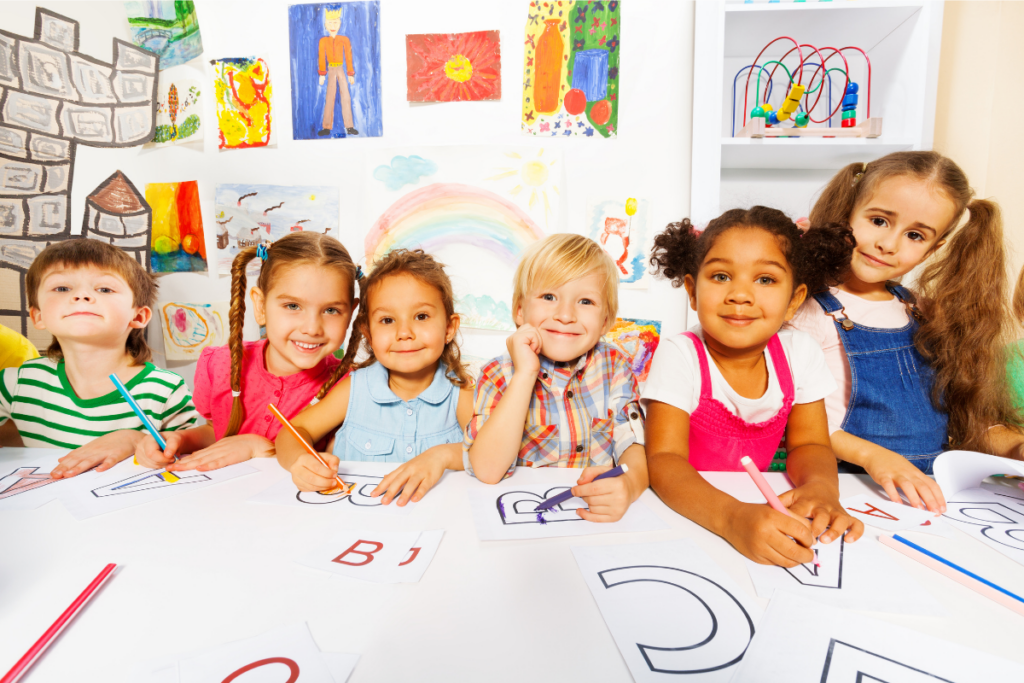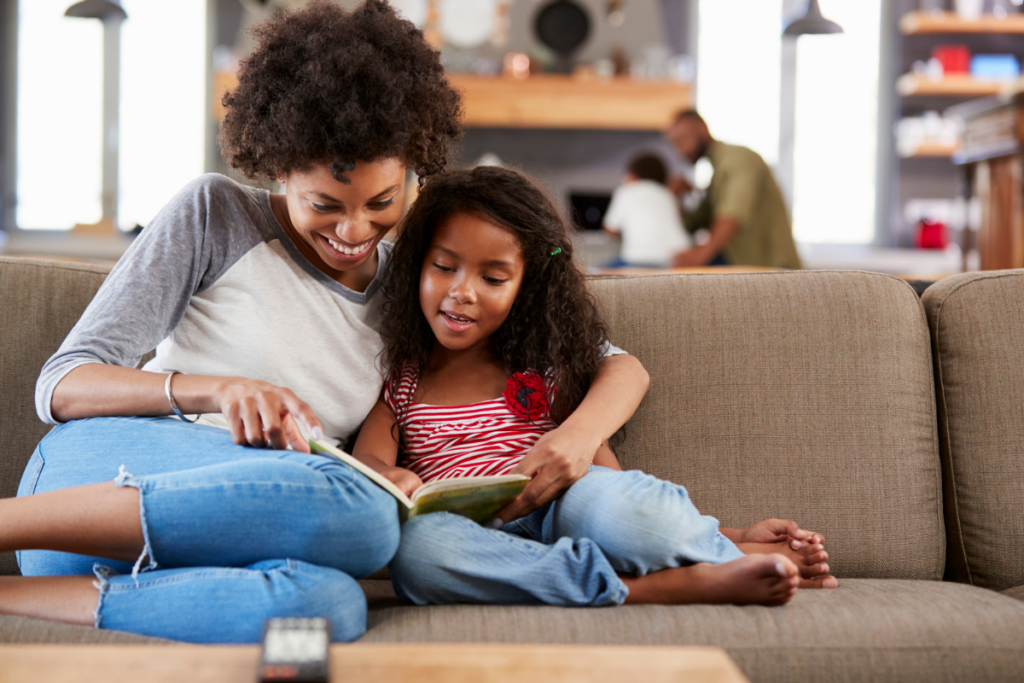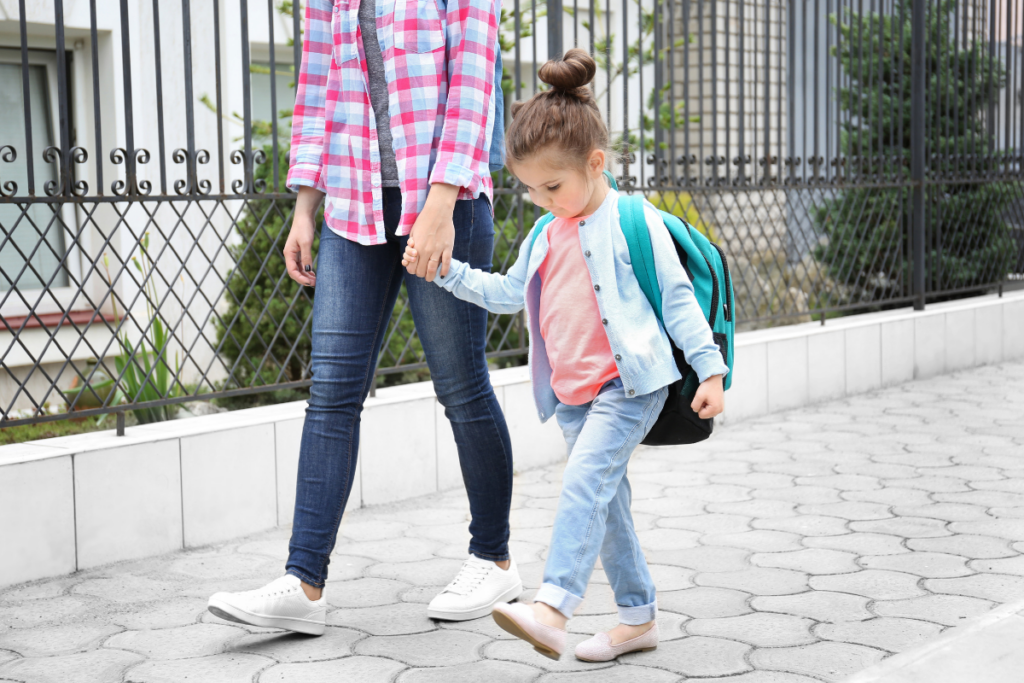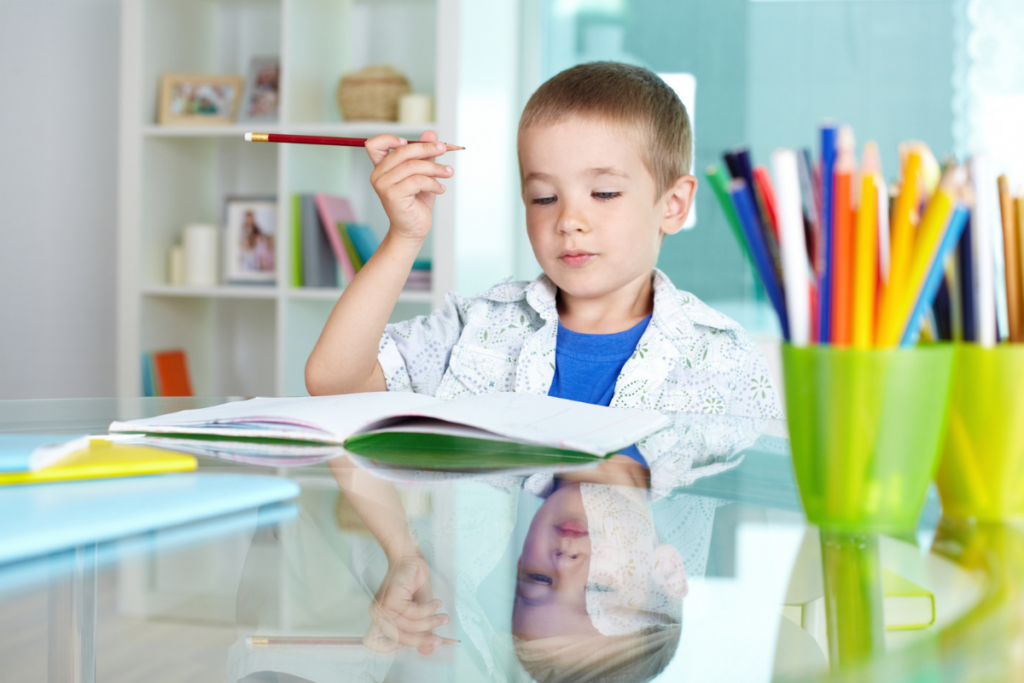Is My Child Kindergarten Ready?
If you have a preschool aged child, chances are you have this question in the back of your mind: Is my child ready for kindergarten? In this post I’m going to walk you through some general guidelines for the expectations of children that kindergarten teachers have and we’ll dive into the details of the essential kindergarten ready academic and social skills.

Sending our children to school is one of the most exciting and terrifying things we ever do as parents. We wonder if they’re ready, if they’ll make friends, if they’ll be able to learn in their new surroundings, if they’ll be safe and loved, the list goes on and on. How do we know we’re making the right choices?
WHAT DOES SCHOOL READINESS MEAN?
School readiness refers to whether a child will be successful in a school setting. There are so many things that go into this, and we’ll discuss them all today. Some of these factors are:
- social skills and maturity
- academic skills
- emotional awareness and maturity
- fine motor skills
All these things together determine your child’s level of success inside an elementary school classroom.
You’ll want to take a minute to grab the teacher designed kindergarten readiness checklist that’s included in this starter kit and you’ll also want to bookmark this post that guides you through the kindergarten readiness checklist.

Your Child as A Person
Before we get into the nitty-gritty of academics and requirements, I want to make one thing very clear.
Who your child is as a person, and their emotional wellbeing must come first. Their ability to calm themselves, express themselves, and be confident in new situations is more important than whether they know the alphabet or can tie their shoes.
The ABCs and 123s matter and they’ll be vital in kindergarten, especially as school systems must focus on academic skills because of their own standards and requirements.
We are going to teach our children these vital skills without putting who they are becoming as people on the back burner.
You are your child’s first teacher, and these super important skills start at home. Ask yourself these questions:
- Can my child calm themselves down when they get upset?
- Can my child handle being told no?
- Can my child work through their feelings of disappointment?
- Is my child comfortable on their own in new situations?
- Can my child say goodbye?
- Can my child recognize and express their feelings?
- Does my child understand that having big feelings is okay, and how to move through them?
If the answer to any of these questions is no, then that is your starting point to helping your child get ready to start school.

How Can I Help My Child Become Emotionally Mature?
Let’s go through each of these necessary skills for your child’s emotional development.
IDENTIFYING FEELINGS
Being able to recognize the emotions they are feeling doesn’t just come naturally to children.
We really need to teach and nurture this skill early on, and thankfully there are tons of ways to do it.
- Name their feelings. Here’s what that sounds like:
- “Mommy has to go to work, and you are so sad we have to say goodbye.”
- “Sister took your toy from you, and it made you mad.”
- “That spider fell on your shoulder, and you were really scared!”
- “You are so excited that we are going to the zoo tomorrow!”
- “Mommy came home, and we are both so happy!”
- “This is a new ride, and you want to go, but you are feeling nervous to try something new.”
2. Read books about identifying emotions. Here are some great ones to get you started:
- How Do I Feel? A Little Guide to My Emotions
- A Little Spot of Emotion Box Set
- My Body Sends Signals
- I Just Don’t Like the Sound of No (and anything else by Julia Cook)
- Slumberkins – Ibex Set
3. Play games that center around identifying emotions. After all, children learn best through play! Here are some great feelings games for you to try:
- Daniel Tiger – Guess the Feelings Game
- Feelings Bingo – TPT
- Feelings Flashcards
- Feelings Twister – Tape emojis to the different colors on a Twister game. Instead of calling out a color, call out a feeling!
- Feelings Lilypad Hop – Place paper lily pads with emojis or flashcards taped onto them. Children will identify the feelings and a time they felt that way as they hop around the room on the lily pads.
Grab the FREE your Peschool at Home Starter Kit
Includes a teacher designed Kindergarten Readiness Checklist + so many more valuable insights!
COPING WITH BIG FEELINGS
The next step in emotional development after children can recognize their emotions and the emotions of others is to learn how to deal with those emotions in a safe and healthy way.
This will look almost identical to teaching them how to identify their feelings, except we take it one step further.
- Model Coping Skills – a.k.a. Monkey See, Monkey Do
- “Mommy is feeling angry right now, so she’s going to walk into the other room for a few minutes. I will come back once I’m feeling calmer.”
- “Daddy is feeling frustrated. I’m going to take some deep breaths until I feel better.”
- “I’m feeling confused right now about what Daddy just said. I’ll going to ask more questions so that I understand.”
- “I’m feeling sad right now. I know that it is okay to cry and feel sad and want to be alone. So, I’m going to go into my room and be alone until I feel better.”
- “I’m disappointed that we couldn’t go to the zoo today because it is raining. That’s such a bummer, but I know that the zoo will still be there another day when it is sunny. Can you help me think of something we could do inside instead?”
- Validate and regulate their emotions for them. Young children just learning cannot do this on their own yet, so let’s help them out. Here’s what this sounds like:
- “You are so mad that Mommy said we can’t go to the park today. That is super disappointing. Can you take some deep breaths with Mommy?”
- “You are so sad because Daddy is having a Disney day with sister, and you don’t get to go. It can be hard to feel left out sometimes. Let’s think of something fun that we can do together!”
- “You are so happy right now because the sun came out! Let’s have a dance party outside!”
- “Your feelings are hurt because your friend said something mean to you because she’s having a bad day. Do you need a hug? It’s okay to cry.”

- Read books about handling big feelings. Here are some book suggestions to get you started:
- Breathe Like a Bear: 30 Mindful Moments for Kids
- Can Quilliam Learn to Control His Temper?
- B is for Breathe: The ABCs of Coping
- The Choices I Make
- A Flicker of Hope: A Book About Depression and Asking for Help
- Slumberkins Alpaca – Stress, Anxiety, and Coping Skills
- Role Play – actually act out common situations and practice working through them. You can play games like:
- Scenario Cards – Read a scenario of a child dealing with big feelings, and practice how that child should react.
- Rewind and Redo – After a situation has de-escalated with your kiddo, go back, and think through it. What happened? How could we have reacted differently? Let’s act out what happened, but this time, we’ll do it the way we just talked about.

Note: No child will regulate their emotions perfectly all of the time.
We are not going for perfection here and kindergarten teachers definitely won’t expect your child to be 100% emotionally regulated. Our goal is for our entering kindergarteners to be able to well regulate their emotions most of the time.
Okay, My Kid Can Regulate. Now What?
Excellent! You’re on your way.
Now that your child can handle their emotions, we can focus on academic and social skills. Out of the two, social skills are where you’ll focus next.
Same idea here as with emotional regulation.
Before students can learn, they need to be able to follow routines and get along with others.
PRACTICE SCHOOL ROUTINES AT HOME
Teach your child how to do some of the basic routines they’ll be required to do at school. Doing so will help with feelings of frustration or confusion.
These could be things like:
- Sitting on a specific spot on the carpet.
- Standing in line in a certain spot (and knowing what it means to stand in a line)
- Walking to destinations instead of running.
- Sitting down to eat lunch at a certain time.
- Opening all the types of containers they might have at lunch.
- Paying attention to an entire book read aloud.
- Give your child some simple directions to follow.
- How to hold a pencil/crayon. (fine motor skills)
- How to use scissors/glue. (fine motor skills)
- Tying shoes. If your child is still having a really hard time tying their shoes, I encourage you to consider Velcro for school and continue to practice at home.

TEACHING SOCIAL SKILLS
Learning to handle problems with others and how to avoid them in the first place is hard!
I bet you can think of a few adults still can’t do it.
Here’s how we help our kids get along with others:
- Be Around Others! You can’t learn to get along with other kids if you aren’t around other kids. Some ideas could be:
- Go to the park and let your child play with others.
- Go to the library for read alouds or special events.
- Invite a friend over for a playdate.
- If you can, put your child in a team sport or activity or join an organized playgroup.
- Get out in the sun and swim in the neighborhood pool or the splash pad at the park.
It’ll be especially hard for this generation of incoming kindergarten students after the hard few years we’ve just had. All we can do it try to get some social practice in for them now.
Mom Tip: Ask in Mom Groups
I’ve found the best place to get suggestions for organized activities for children is in my local moms Facebook group. All of our favorite activities, including my town’s family resource center’s organized playgroup (which is my favorite activity for my kiddos) have come directly from suggestions from other moms. Search Facebook for [your town] mom group and I bet you’ll find something. And don’t be afraid to ask – moms love supporting each other.
There are so many wonderful and organic ways to get your child interacting with others.
Otherwise, you probably know what I’m about to say.
- Roleplay! This is such an amazing tool! Here’s what roleplaying social interaction sounds like:
- “Your friend wants to play with a toy you have, so she snatches it from you. What do you do? Let’s practice.”
- “Someone you don’t like so much is told to sit next to you. What do you need to do? Let’s act that out.”
- “Your friend wants to play a different game than you. Let’s practice how to respond.”
- Read books about social skills and conflict resolution. Here are some suggestions to get you started:
- Talk and Work It Out!
- What Should Danny Do?
- A Little Spot of Empathy
- Personal Space Camp
- Teamwork Isn’t My Thing, and I Don’t Like to Share!
- Slumberkins Hammerhead – Conflict Resolution
I swear I am not sponsored by Julia Cook or Slumberkins, they are just seriously that good.
Grab your Free Preschool Activity Pack

My Child is Socially and Emotionally Ready. What’s the Next Step?
This probably isn’t news to you mama, but kindergarten looks a whole lot different these days than it did when we were 5 or 6 years of age.
Back then, the common expectations were having had our fifth birthday and knowing our home phone number.
Your child’s teacher will have your home number, cell number, work number, and 3 backup numbers saved in their contact system.
Academically, kindergarten looks more like what first grade looked like for us.
All of the social development got pushed to home and your child’s pre-k teacher if they have one (which of course. could be you).

Kindergarten is about learning to read, learning to add, learning to write. It’s so academically rigorous.
I’ll give you the inside scoop on exactly what’s expected.
ACADEMIC SKILLS
Generally, when we think of kindergarten, we think of a colorful room with lots of playtime, crafts for the letter-of-the-week, and number-of-the-week.
While still housed in colorful and loving classrooms, the pace is much quicker now, and the expectations for what children come in knowing are astronomically higher.
This means that as expectations and learning standards rise, kindergarten readiness falls.
I don’t want to freak you out. But the rigors of kindergarten are real. I’m here to set you up for success and help you give your child a solid foundation for their early childhood education.
Grab the FREE your Peschool at Home Starter Kit
Includes a teacher designed Kindergarten Readiness Checklist + so many more valuable insights!
So, what can you focus on as parents?
Be sure that you have your copy of the free teacher designed kindergarten readiness checklist that’s included in this starter kit and you’ll also want to read this post that guides you through the kindergarten readiness checklist when you’re done here.
PRE-READING SKILLS
While your child doesn’t need to be reading books when they enter kinder, they do need to be ready to read.
This means phonemic awareness a.k.a. the recognition that letters have meaning, and a sound attached to them is crucial.
What should your child know?
First, all 26 letters of the alphabet.
Both the letters themselves and the sounds they make. Bonus points if your child can write some.
If you need help teaching your child letter skills, I designed this system that’s made letter learning easy for more than 10,000 families.

Ideally, your child should be able to match a letter with its sound, and the letter to a word that begins with that sound. This looks like being able to:
- Show that the word “dog” starts with the letter “d” and its sound.
- Match the correct letter to the correct letter sound.
Next, your child needs to know their first name.
This means they know the letters of their name, how to spell it, and it’s best if they know how to write it too.
I know these sound like skills your child would be learning in kinder, but, kindergarten teachers are expected to breeze through letter skills and get started teaching how to read quickly.
Book Handling Skills
The knowledge of the parts of a book and how they work.
You’re looking to see if your child knows:
- What the front cover, back cover, and spine are and where they are located.
- Pages are read from left to right.
- Text are read from top to bottom of each page.

Early Number Skills
These are skills like:
- Identify numbers 1-10. Really, 1-20 is even better.
- Count with 1-1 correspondence.
This just means that your child can count and if asked to count three cars, they will actually point to one car at a time as they count. Children tend to start counting by pointing to only one object and swiftly counting to three.
- Basic number matching.
- Meaning your child can look at a picture with 5 ladybugs and place the number 5 with it.
If you need help teaching your child to identify, count to, and write numbers 1-20, I have a super effective system for that too. It’s called the Ultimate Numbers Learning Kit and you can see it here.
I Think My Child Knows These Things – How Do I Tell They Are Ready?
First, go through this free kindergarten readiness checklist.
Chat with your child’s doctor at their 5 year old well visit. Be comfortable asking questions about your child’s readiness.
Depending on the kindergarten program that your child will be entering, there may be kindergarten readiness screenings.
Grab the FREE your Peschool at Home Starter Kit
Includes a teacher designed Kindergarten Readiness Checklist + so many more valuable insights!
District Kindergarten Readiness Screeners
Here’s what you need to know about screenings:
- These are given by the local school district your child will be attending, usually, a couple of days before school begins, or the few days right after school begins.
- Each state has its own version of screener, which you can usually find on your state’s Department of Education website, or your district’s website.
- When your child is given this screener, ask the teacher to sit down with you to go over the results and give you more tips for what to work on at home.
TESTS YOU CAN DO AT HOME
Let’s take the pressure off and make this fun.
Playing games is a great way to evaluate your child’s skills.
While having fun, your little learner is still showing you what they know. Testing this way also gets your kiddos more hands-on in their learning.
Here are some ideas for you to try:
- Alphabet Nature Walk
Get outside! Take your child on a walk, and as you are enjoying the outdoors, play this game.

It works basically like I Spy.
- “I see something that starts with the “g” sound. What is it?”
- “I see a leaf. What letter and sound does leaf start with?”
You could absolutely also do this indoors with toys.
- Pick Up, Number Up
This is a great way to check that 1-1 correspondence!
- Drop a bunch of non-breakable toys or pieces of candy on the floor or table.
- Ask kiddo to pick up a certain number of those objects and see what they do. If they are ready, they will pick up the correct amount.
- Flashcards!
- These can be as creative and cute as you want them to be.
- Flashcards will always be a fantastic strategy. They can literally be used for everything.
- The teacher created kindergarten readiness checklist in this kit is going to be a game-changer!
- There lots tips for helping preschool children learn included too.
- It’ll be your go-to directory for all the learning resources you need.
All right! I think we’re ready!
How and When Do We Sign Up?
There are a few things to look at as parents to decide what age you are going to register your child for kindergarten or begin homeschooling a kindergartener.

REQUIRED AGE
Many districts/states have an age requirement for children to start kindergarten, and this varies by state. Some states allow children as young as 4, and others need a student to be 5 or even 6 before they can register.
The cutoff date for your child’s birthday will depend on the rules of your state and a simple Google search will help you find that answer.
As a kindergarten teacher and mom, I’ll share with you that my son is actually on the cut off to attend kindergarten next year.
He has an October birthday and in our state children need to turn 5 by January to start kindergarten in September.
He is just about academically ready to start (teacher mom and all) but we are giving him the extra year and not sending him to kinder til he is 5.
And I feel really good about this choice.
We’re not in a rush and I know that extra time can only benefit him. It’s really not just about whether he’s ready academically to start kindergarten. I feel good knowing he won’t be rushing to college at 17 and he’ll have that extra year to build up emotional maturity.
If you want to hear another mom’s perspective, I love this post from Busy Toddler about why she chose to delay kindergarten for her child.
If your child is at an eligible age, and you feel they are ready for the kindergarten challenge, congrats! Here are your next steps.

WHERE AND WHEN DO I REGISTER?
There are several simple steps here.
- Figure out the school you are zoned for in your district. Almost every district has a Find My School type of page for parents to see which school they should be going to.
- Look up that school to see the registration dates for kindergarten, and any other events they could be hosting for new kindergarteners.
- Call the school. This is important because you want to have all the documents and information required to register when you go in. If not, it is headaches all around. The secretary of the school your child will be attending will have all that information to give you.
- Go to the school at the time set for kinder registration with all your documents. School staff will help you take care of all the paperwork, tell you about the first day of school, and may also set up an appointment for a kindergarten screener.
Kindergarten registration might be electronic in your district. Just be sure you know the correct procedure.
It would also be a great idea to ask other moms for their experiences in one of those super helpful mom groups!

What If My Child Isn’t Ready to Start Kindergarten?
So, your child isn’t quite ready yet.
Maybe they are not handling emotions very well yet, or maybe they just really can’t grasp letters. Maybe they aren’t turning 5 until September and they’d have to start the year as the youngest and smallest in the class.
There are so many reasons why your child may not be ready to start kindergarten, even if they are eligible to do so. There is a term for keeping kiddos who are eligible back another year.
What Is Redshirting?
Having started out as a sports term (generally with the idea that older children will be bigger and do better in sports), it has now come into the education world with almost the same meaning.
Redshirting is the act of a parent or guardian holding a child back another year to start kindergarten, even though they are eligible to start according to the state.
Personally, I’m not going to encourage you to hold your child back just so they’ll maybe do better in sports. But there are about a thousand other valid reasons you may want to wait.
And mama, that’s okay.
An additional year of early childhood before the hard work of kindergarten starts might be your best option.
Studies show that most families will make this choice due to a child not having the emotional or social maturity needed to function in a classroom and learn at the same time.
Like anything else in parenting, there is no clear right or wrong answer here.

Everything depends on each individual child’s needs, and no one knows those needs better than you do as their parent. With that being said:
It is always the right choice if it is what is best for your child.
I’ll say it again for those in the back:
It is always the right choice if it is what is best for your child. You do not have to feel guilty or pressured because of the choice you make for YOUR child.
Period.
If In Doubt
If you’re not sure what the right choice is, remember that you can always seek advice from your child’s preschool teacher, daycare provider, or your child’s doctor. They should be able to provide some helpful feedback.
IS MY CHILD READY FOR KINDERGARTEN?
At this point, you have all the information you need to know.
Please don’t put too much pressure on your child’s readiness during this exciting time.
There is no single factor that will determine your child’s success.
All children learn new things at different rates. The rest of your child beyond academics matters a whole lot too.
I know you’re working hard to help your child be ready to enter the kindergarten classroom. If you’d like a little extra help along the way, I’ve got you covered.
Your next step is to join my community of over 80,000 moms to have my devoted support along this journey & grab some really fun, helpful freebies too.




